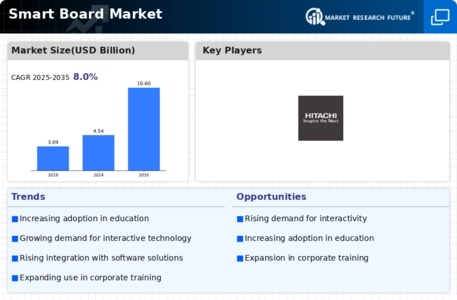Leading market players are investing heavily in research and development to expand their product lines, which will help the Smart Board market, grow even more. Market participants are also undertaking a variety of strategic activities to expand their global footprint, with important market developments including new product launches, contractual agreements, mergers and acquisitions, higher investments and collaboration with other organizations. To expand and survive in a more competitive and rising market climate, the Smart Board industry must offer cost-effective items.
Manufacturing locally to minimize operational costs is one of the key business tactics used by manufacturers in the global Smart Board industry to benefit clients and increase the market sector. In recent years, the Smart Board industry has offered some of the most significant advantages to the educational sector.
Major players in the Smart Board Market, including Hon Hai Precision Industry Co., Ltd. (Foxconn) (Taiwan), Hitachi, Ltd. (Hitachi) (Japan), Samsung Display Co., Ltd. (Samsung) (South Korea), LG Display Co., Ltd. (LG Display) (South Korea), Panasonic Corporation (Panasonic) (Japan), NEC Display (NEC) (Japan), Ricoh Company (Ricoh) (Japan), Google LLC (Google) (US), Cisco Systems, Inc. (Cisco) (US), Microsoft Corporation (Microsoft) (US) are attempting to increase market demand by investing in research and development operations.
Hitachi Ltd (Hitachi) is a multinational conglomerate operating in various sectors, including information technology, electronics, power systems, social infrastructure, industrial systems and construction machinery. The company specializes in the manufacturing and distribution of a wide range of products and services, such as information and telecom systems, power systems, social infrastructure and industrial systems, construction machinery, electronic systems and equipment, automotive systems and smart life and eco-friendly systems. These offerings cater to diverse industries, including manufacturing, communications, finance, healthcare and life sciences, government, energy, automotive, aerospace, transportation, nuclear and technology.
Hitachi operates through a network of affiliates, subsidiaries, associates and joint ventures spanning across regions such as Asia-Pacific, North America and Europe. The company's headquarters are located in Chiyoda-Ku, Tokyo, Japan. In October 2017, Hitachi unveiled the release of Hitachi Data Instance Director (HDID), version 6. This product enables companies to enhance recovery processes and eliminate backup windows. HDID leverages snapshots, clones and replication functionalities on HDS storage arrays.
LG Display Co Ltd (LG Display) is a leading manufacturer and supplier specializing in thin-film transistor liquid crystal display technology, with a focus on designing flexible displays, organic light-emitting diode (OLED) screens and other advanced display panels. The company's diverse product portfolio includes commercial displays, notebook displays, TV screens, mobile device displays, monitor screens, automotive displays and more. These display panels are available in various sizes and configurations to meet different market demands. LG Display leverages cutting-edge technologies such as OLED and LED to enhance its product offerings.
Its displays are utilized in a wide range of applications, including notebook computers, desktop monitors, tablet devices, smartphones, automotive infotainment systems, portable navigation devices and medical diagnostic equipment. Operating across key global regions including China, the United States, Singapore, Japan, Malaysia and Germany, LG Display maintains a strong international presence. The company's headquarters are located in Seoul, South Korea. In a move to further its business expansion and innovation efforts, LG Electronics inaugurated a new business innovation center in Chicago, US, in February 2016, aimed at fostering development in LG's commercial displays and business solutions sector.











